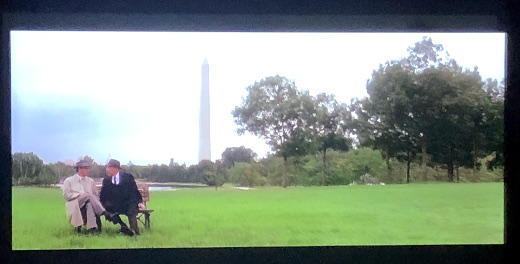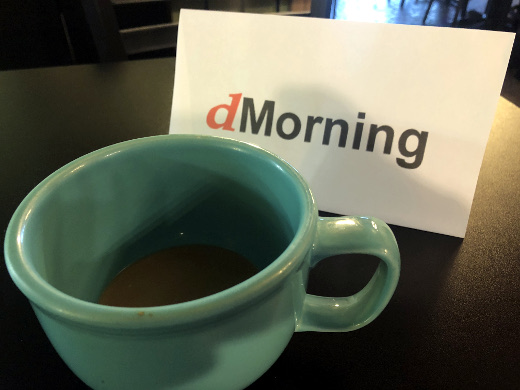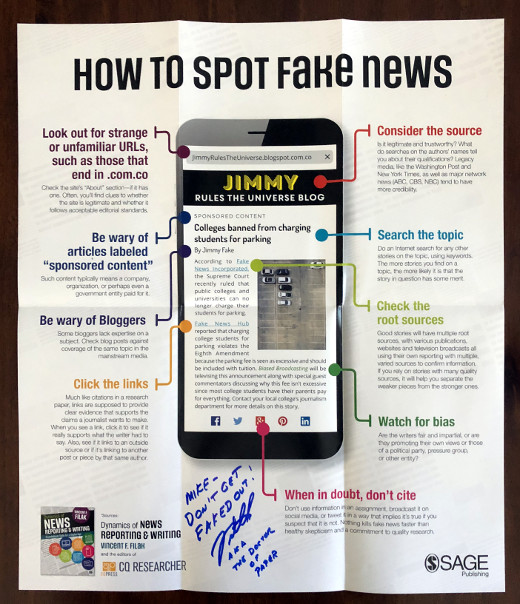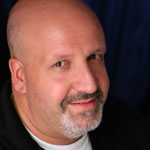3 Things I Do Differently Living In Appleton Wisconsin
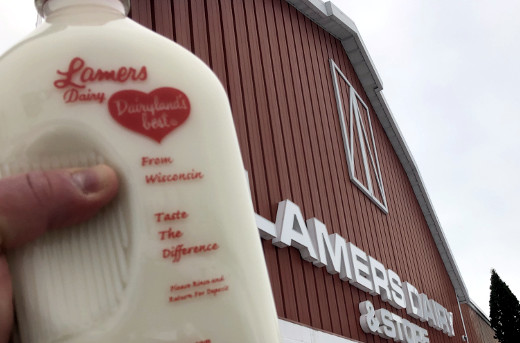
It’s been almost 2 years since my family and I moved to Appleton, Wisconsin. It has been a good move, though I haven’t written about it much, save the local obsession with roundabouts.
What makes it a good move is that I like to embrace where I am, and have enjoyed the process here. I learned to do this many years ago when I was frequently traveling for work, spending long periods of time away from home in exotic locales like Louisville, Kentucky and Phoenix, Arizona. A large part of that embrace was doing things that people local to the area would do… well at least the positive things!
Looking back on this near biennium, 3 things come to mind that I am doing differently since relocating to Appleton from Chicago, all which have been a good thing.
Eating and Drinking Locally-Produced Products – As my license plate says and I see all around me, Wisconsin is America’s Dairyland. When I found Lamers, a local dairy that sells milk from local cows in glass bottles in a store in front of where they bottle it, I was all over it. We now get all of our milk from there, and their milk makes great soft-serve ice cream which is sold in their dairy store. In addition to milk, I try to buy other dairy products – namely cheese – made as close to home as possible.
On the protein front, locally hatched eggs as well as meats from my new favorite local butcher shop Jacob’s Meat Market, are often on our dinner plates. It not only makes sense to buy bacon cured from local pigs about 20 feet from where it is sold, but additionally with all of the recalls on mass-produced meat products, knowing the source is very important.
Where one cannot live on meat and dairy alone, the Fox River Valley of Northeast Wisconsin is also home to great breweries like Stone Arch and the Appleton Beer Factory. There’s much, much more than Miller Lite in Wisconsin!
Reading Local Newspapers and Listening to Local Radio – Coming from such a large city as Chicago, most news stories there were on a grander, city-wide scale. It was hard to find coverage of stories specific to a neighborhood, which drives the term “hyper-local” news. As someone who is now on a decade of being without Cable TV, when I moved here I sought out local media outlets online on Twitter to help me understand the happenings of my new surroundings.
In the process of finding these, I dove deeper into their coverage. We have a subscription to the Appleton Post-Crescent, the local newspaper which, like most other mid-sized papers in the state, is owned by USA Today’s parent Gannett. Our subscription is only a digital one, which is fine since the local printing plant closed and the papers are printed over an hour away, guaranteeing most late sports games and other events will not make the print edition. The coverage by the small (and increasingly smaller) staff of reporters helps keep me informed of happenings I otherwise wouldn’t otherwise know of.
I have also re-embraced a medium I haven’t engaged with in a long time, local radio. For someone whose college experience was tied to the campus radio station this has been welcome. As outside of my car I don’t own a radio, fortunately I can stream radio shows and coverage by computer and mobile app, and listen to them as podcasts. In addition to the ease of the medium, the depth of coverage has been tremendous. One show specifically, Fresh Take with Josh Dukelow on WHBY, not only covers a wide breadth of topics from politics to culture, but also goes into great depth on them as well. I have been exposed to a lot of nuances of the area I would not have otherwise known about if it wasn’t for Fresh Take.
Using Ride-Sharing Services – Though certainly not something unique to this area, prior to moving to Appleton I never used services like Lyft and Uber. Coming from Chicago, where I lived steps from subway stations, major bus routes and plentiful taxis, I had no need for them. I must also admit I knew many cab drivers in Chicago who were being negatively impacted by these services as they started, and those were a deterrent to me using them. Though there are taxi services here, they are not as plentiful or to the demand-level that I am used to. This has made using Lyft in particular a great addition to my routine.
Where these are some great additions to my routine, I hope in the future I can add more to this. If you have any suggestions of other things I can do in the Appleton area, please share them in the comments to this post. And be nice!
Deconstructing Embracing What is Local
As I have traveled across the country and around the world, I have always sought out what is unique or local to the area, and tried to go beyond what is simply touristy. I have taken the same approach here in Appleton, Wisconsin and have been pleased with the results. Embracing the best of what is around you can enhance your life.
This is from The Hot Iron, a journal on business and technology by Mike Maddaloni.
Did you enjoy this? Subscribe to The Hot Iron by RSS/XML feed or Read by Email
Business •
Thrive •
(0) Comments •
Permalink
JFK Movie Park Bench Moments
Have you ever been in a situation where you had a hunch about something but weren’t quite sure of it, only for someone to come along and not only reaffirm your hunch but get into details you wish you had not known?
How about this happening to you more than once?
These situations are what I refer to as “JFK Movie park bench moments.” They have happened a couple of times in my career, and I’d like to share these here.
But first, the movie scene
If you have no idea of what I am talking about, let me explain. JFK is a movie starring Kevin Costner and directed by Oliver Stone that came out in 1991. It was about the assassination of US President John F. Kennedy through the eyes of the District Attorney of New Orleans, Louisiana, Jim Garrison.
When Garrison discovers a possible connection to JFK’s murder in New Orleans and his investigation goes public, he travels to Washington, DC to meet someone called “X,” played eerily by Donald Sutherland. They meet around the Washington Mall and sit on a park bench where X proceeds to tell Garrison that not only is he on the right track with his investigation, but provides details about it that are almost too incredible to believe. Of course when Garrison asks X to testify in his trial he says no.
Fast forward a few years
I always remembered that scene from the movie as was so unique – 2 men, sitting alone on a park bench away from – but close to – so many, with one learning the “straight dope” of what led to JFK being shot in Dallas, Texas from the other. This scene came back to me a couple of times in my career after first seeing the movie, when I found out about truths about jobs I had that, in both cases, convinced me to leave before I would have been terminated!
The Numbers and People Lie
After finishing a long-term consulting project with a firm I was working for, I went back to the firm’s office on a weekend to take care of some paperwork. When I printed a few things I grabbed the printouts from the printer only to also get some reports left on the printer by someone else. Among them was a revenue report showing me at the top of the report. Where one’s ego might be stroked to see that, my hourly rate was extremely low for the senior role I had managing the project I just left. Further down on the report were many people who were not bringing in any revenue at all.
Was all I heard about how well the firm was doing a lie? The next week I went to lunch with another consultant at the firm. Armed with the knowledge of this revenue report but not wanting to disclose it, over the meal I asked him how he thought the firm was doing. Thank goodness I have a strong stomach, as I would have tossed it up my lunch after our conversation. The modest cafeteria we were in served as the park bench and grassy for my JFK movie moment as he told me what he knew about the vitality of the firm.
This was eye opening, shocking, yet gave me a great calm in the next steps I took to leave the firm, which I did a few months later. Another six or so months after I left, the firm itself shuttered, leaving some smart people caught in a reaction to my earlier pro-action, scooped up by other lucky companies soon after.
Building the ship while it is sailing is not a good idea
Later in my career I took a leadership role on a high-profile project for an international firm. As one of the first people to join the project team, I not only had the good fortune to be able to build my own team from the ground up, but was involved in much of the interviewing across the project, helping to ensure people who joined would work well in our culture.
Early on I met with one of the senior leaders of the team, who gave an analogy in describing what we were doing that I would never forget, as he said we were “building the ship while it is sailing.” Where initially I saw this as a great opportunity, this feeling waned over time as I felt those sailing and building were far from being in sync.
There were a few managers on the project I got to know – some better than others, and one night as I was departing the office I ran into one of the managers I knew well. We chatted a bit, then felt a local pub would be a better venue to continue our conversations. After a few beverages and some good food we departed for home heading in the same direction. He was staying in a corporate apartment in a place I could never afford.
He invited me to check out said apartment and to continue our conversations. I sat in an oversized leather chair, he poured a couple of glasses of Hennessey, placed the bottle down, and then I sensed another JFK movie park bench moment in the making. He proceeded to reaffirm a lot of the concerns I had on the project, and blew me away with the history and politics of the project, and his projections for where it was going to go. Needless to say that bottle of Hennessey didn’t last long as the tales of international intrigue flew around the room.
But like before, as uncomfortable as it was to hear, it was exactly what I needed to hear. The next morning, as bleary eyed as I was, I started my quest for a new gig which I landed a few months later. Sadly within a year the whole project was shutdown, after a tumultuous ride for the dedicated team that stuck around through it all.
Deconstructing JFK Movie Park Bench Moments
Life has many mysteries. Some of them we find out, but many we go to our grave never knowing the real story of what went on. Whether or not what X was telling Garrison in the movie was completely true or not – and we may never know either way for sure – the drama of the moment stands out and can be a catalyst for action. For Jim Garrison it was to pursue the truth of the JFK murder, for me it was to find new jobs. What could it be for you?
This is from The Hot Iron, a journal on business and technology by Mike Maddaloni.
Did you enjoy this? Subscribe to The Hot Iron by RSS/XML feed or Read by Email.
Business • Strategize • (0) Comments • PermalinkNext dMorning Tech Creative Networking Event on November 9
The next dMorning meetup networking event will be on Friday, November 9 from 7:30 – 9:30 am at Copper Rock Coffee Co., 210 W. College Avenue in Appleton, Wisconsin.
dMorning was started to provide a casual environment for those who work in the technology and creative fields in Northeast Wisconsin to meet, network and have a beverage of choice. The idea is to meet in the morning before the day gets hectic. There are no set rules and no agenda. More information is available at dMorning.com.
Hope to see you there!
This is from The Hot Iron, a journal on business and technology by Mike Maddaloni.
Did you enjoy this? Subscribe to The Hot Iron by RSS/XML feed or Read by Email.
Announcements • Business • Technology • (0) Comments • Permalink
My Guest Lecture at University of Wisconsin – Oshkosh on Consulting
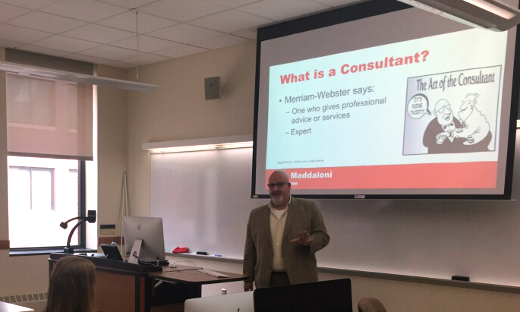
Great interactive classroom instruction coupled with real-world work opportunities provide the best educational experience for students. When you have the chance to help make that happen, it’s extremely rewarding. That happened for me recently as I was a guest lecturer at a university class.
I was honored to be asked once again by Dr. Sara Steffes Hansen, a professor at University of Wisconsin – Oshkosh and chair of the Journalism department. Her class, Application of New & Emerging Media, provides that educational experience working with entities in the community on their social media and beyond. As her students make on-site visits to their clients, I was asked to speak to the class on the topic of consulting.
Last year I spoke to students in the same class, but after their client visit, where this year it was ahead of it. As meeting face-to-face with clients involves many factors – factors many don’t execute on well – I incorporated a role play into the interactive lecture. With a “volunteer” student, I did an improvised sketch where the student was the client and I was the bumbling, unprepared consultant. This segued into my discussion on preparing for and executing on the on-site visit, as well as the follow-up and deliverables from the class assignment.
For me, this guest lecture served many purposes. As I have learned from others, both in the classroom and in the real world, I welcome the opportunity to share my experience and “war stories” with the students. As someone who still thinks and works like a consultant, poor consulting skills from others stick out like a sore thumb soaked in sriracha and lit on fire! If this lecture can help guide students down the path of honing their consulting skills, then the world will be that much better.
This class is part of the UW – Oshkosh’s Interactive Web Management major, which is a combination of curricula from Computer Science, Marketing, Journalism and Information Systems. It is a unique major, mashing up key aspects of each of these areas to offer a comprehensive educational background for how companies today are staffing roles in marketing and tech.
Where you needed to be enrolled in the class to get the full lecture, I am sharing my slides. You can link to the slides from my guest lecture here on SlideShare, or view them embedded below. I am planning on coming back to the class at the end of the semester to watch their client presentations. In the meantime I wish great success to the students of Journalism 61-440!
This is from The Hot Iron, a journal on business and technology by Mike Maddaloni.
Did you enjoy this? Subscribe to The Hot Iron by RSS/XML feed or Read by Email.
Announcements • Business • Strategize • Technology • Thrive • (0) Comments • Permalink
Talking About Fake News in 2004
It seems everywhere you look today you see something about fake news, from those calling something fake news to those who are defending themselves for not being fake news. However, the idea of fake news is nothing new, and as a matter of fact it was something that I was talking about publicly into 2004.
Yes, I said 2004, 14 years ago from now.
So why would I remember today what happened a decade and a half ago? Interestingly I was triggered to recalling it from a poster by a colleague of mine, Dr. Vincent Filak, professor of journalism at the University Wisconsin – Oshkosh. The poster is about how you can spot fake news and was created as a complement to his recently published collegiate textbook, Dynamics of News Reporting and Writing: Foundational Skills for a Digital Age.
Now let’s take a trip back along memory lane and talk about how even then I realized this was an issue that would be impacting not only news but the Internet and the Web as well.
Back in time
In the spring of 2004 I was asked to speak at the annual conference for winners from Massachusetts of the Hugh O’Brien Youth Leadership Award, best known as HOBY, that was taking place at (then) Babson College in Wellesley, Massachusetts. I had been a recipient of the award back in the 1980s when I was a high school sophomore and recently I had connected with the state HOBY organization in Massachusetts because of something I had written. Shortly after the death of retired New England Patriots player Ron Burton, who after leaving the football gridiron was a champion for charitable causes in the Boston area including the HOBY award, I had written about him on my former Web site GoPats.com – as I have retired that Web site, you can read the original article I wrote on Burton here thanks to the Internet Archives’ Wayback Machine.
After connecting with the HOBY organization about my article, they asked me to speak at their 2004 conference for 2 purposes, one as part of a remembrance of Burton and to participate in a panel about the media. The panel was would consist of Steve Burton, a Boston sportscaster for WBZ-TV and Ron’s son, sportswriter Dan Shaughnessy from the Boston Globe and myself, a technology strategist representing the Internet. I was honored to be asked to speak to the students, and I also realized the challenge of representing the Internet along with two well-known journalists, but I was up to the challenge.
As the conference began, following a video tribute of Ron Burton which included a video from Hugh O’Brian himself, I gave my tribute, talking about the 2 times I met him over the years. Next up was the panel on the media, with myself, Burton and Shaughnessy. Each of us had a few minutes for an introduction to talk about our expertise. Burton spoke first, then Shaughnessy and finally myself. As I listened to their opening statements I felt a little intimidated representing all of what the Internet was and is, but is someone who is been working with it professionally at that point for over a decade, I felt very comfortable and confident in sharing my knowledge to these young people who themselves never knew a time without the Internet.
Following this was a Q&A session where the students asked a lot of great questions. One in particular that I remember was on believing what you read online. First Burton spoke, and what I recall from his comments was him talking to journalistic integrity and how on television you had to make sure to get it right the first time, for even if you have the opportunity to retract it later, many people may not see that retraction as you would in a newspaper. When Shaughnessy spoke, he took more of a cavalier approach; I remember him started out by saying that you really can’t believe anything you read on the Internet. This was not surprising to me because this reflected his writing style, which I consider arrogant, and is why I only occasionally read his columns.
After his comment about not believing anything you read online, and while he was still talking, I reached into my blazer pocked and grabbed my PalmPilot handheld device (remember, this 2004 and PalmPilots were what we used back then!) and I opened up the Web clipping app for the Globe, Boston.com, and brought up an article was written by Shaughnessy about the Boston Red Sox that I had just read that morning. When it was my turn to respond I held it up my PalmPilot and, in a casual way, pointed out I had read Shaughnessy’s latest article online and questioned if I should believe it! He was a little taken aback by my opening line.
I continued my thoughts to the students by simply saying you should know your source. Whether you read it online or watch it on TV or read it in the newspaper, you should have an idea of where the information is coming from, and if the method you are reading it is a reputable one. I reinforced the point by saying if you are unsure, you should ask someone – a parent or teacher – and in any case they should take what they have consumed and form their own opinion. This approach is something I keep front of mind and share with others to this day.
And thus a modern journalism guide triggered me to remember that event from so long ago in context to today. To build on that, I not only try to understand the story but the headline as well – there are many Web sites and sources that deliver what ends up being misleading headlines in the hopes of you clicking on them, reading whatever the story is about, and in the process gaining ad impressions on their Web site. I have found these “fake headlines” linking to stories by legitimate journalists I am familiar with, only to read a story that doesn’t match the headline. Knowing your source is not only more involved but vital today.
Deconstructing Recognizing Fake News
Sadly I believe the idea of fake news has been around even longer than before I did my talk back in 2004. The concept of yellow journalism and opinions by early newspaper publishers have tried to influence readers for years. In a digital world where it takes much less resources to disseminate news – real or otherwise – being able to decipher the true from the fake has a greater importance. Where some look to the media companies and the government to solve this problem, the ultimate responsibility falls on ourselves. Buyer – or reader – beware!
This is from The Hot Iron, a journal on business and technology by Mike Maddaloni.
Did you enjoy this? Subscribe to The Hot Iron by RSS/XML feed or Read by Email.
Business • Strategize • (0) Comments • Permalink

